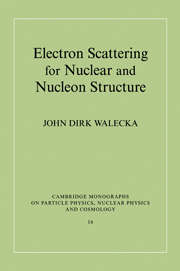Book contents
- Frontmatter
- Contents
- Preface
- Part 1 Introduction
- 1 Motivation
- 2 Pictures of the nucleus
- 3 Some optics
- 4 Why electron scattering?
- 5 Target response surfaces
- 6 Why coincidence experiments?
- 7 Units and conventions
- Part 2 General analysis
- Part 3 Quantum electrodynamics
- Part 4 Selected examples
- Part 5 Future directions
- Appendixes
- References
- Index
2 - Pictures of the nucleus
from Part 1 - Introduction
- Frontmatter
- Contents
- Preface
- Part 1 Introduction
- 1 Motivation
- 2 Pictures of the nucleus
- 3 Some optics
- 4 Why electron scattering?
- 5 Target response surfaces
- 6 Why coincidence experiments?
- 7 Units and conventions
- Part 2 General analysis
- Part 3 Quantum electrodynamics
- Part 4 Selected examples
- Part 5 Future directions
- Appendixes
- References
- Index
Summary
We currently possess three levels of understanding of the nucleus within the following frameworks [Wa95]:
(I) Traditional, Non-Relativistic, Many-Body Systems [Fe71]. This approach uses static two-body potentials fit to two-nucleon scattering and bound-state data. These potentials are then inserted in the non-relativistic Schrödinger equation, and that equation is then solved in some approximation; with few-nucleon systems and large-scale computing capabilities, the equations can now be solved exactly. Electroweak currents constructed from the properties of free nucleons are then used to probe the nuclear system. Although this approach has had a great many successes [Bl52, Ma55, Bo69, Fe71, de74, Pr75, Fe91, Wa95], it is clearly inadequate for a more detailed understanding of the nuclear system.
(II) Relativistic Many-Body Systems. A more appropriate set of degrees of freedom for nuclear physics consists of the hadrons, the strongly interacting mesons and baryons. There are many arguments one can give for this. For example, the long-range part of the best modern two-nucleon potentials is given by meson exchange, predominantly π with (Jπ, T) = (0–, 1), σ(0+, 0), ρ(1–, 1) and ω(1–, 0) [La80, Ma89]. Furthermore, one of the successes of electromagnetic nuclear physics is the unambiguous demonstration of the existence of exchange currents, additional electromagnetic currents in the nucleus arising from the flow of charged mesons between nucleons. In addition, one daily sees copious production of mesons from nuclei in high-energy accelerators.
The only consistent theoretical framework we have for describing such a strongly-coupled, relativistic, interacting, many-body system is relativistic quantum field theory based on a local lagrangian density. It is convenient to refer to relativistic quantum field theory models of the nuclear system based on hadronic degrees of freedom as quantum hadrodynamics (QHD).
- Type
- Chapter
- Information
- Publisher: Cambridge University PressPrint publication year: 2001



